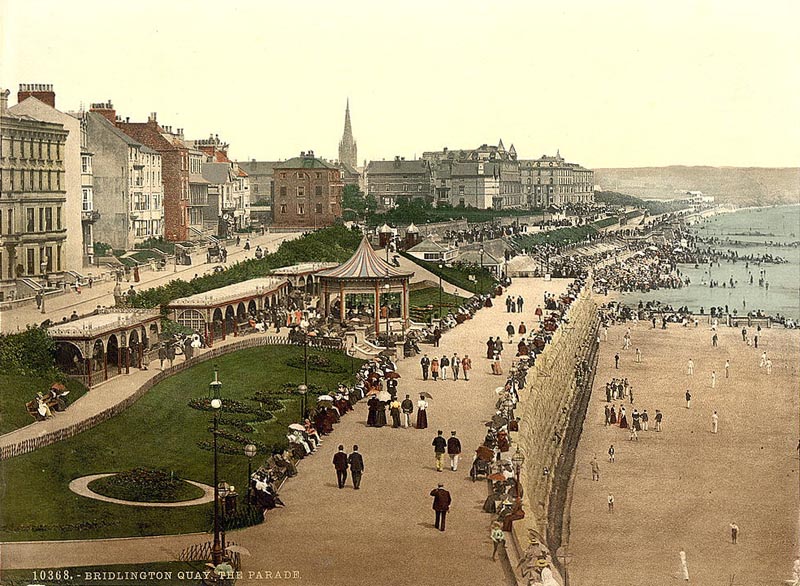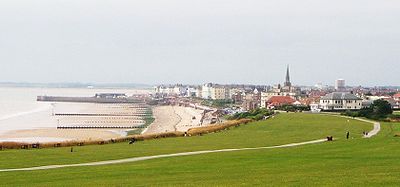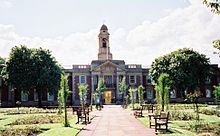Contact Beth Northrop
ejnorth123 AT juno.com
![]()
Bridlington
|
Bridlington is a seaside resort in the bay south of and sheltered by Flamborough Head. It is a minor sea fishing port and civil parish on the Holderness Coast of the North Sea, in the East Riding of Yorkshire, England. It has a static population of over 34,000, which rises considerably during the tourist season. Bridlington is a major shellfish port and has a working harbour. The town is twinned with Millau in France and Bad Salzuflen in Germany.[2] One of the UK's coastal weather stations is located at Bridlington.
one of many postcards from http://www.oldukphotos.com/yorkshire-bridlington.htm
Bridlington is a seaside resort and minor fishing port on the Holderness Coast of the North Sea. It is an area which is said to have the highest coastal erosion rate in Europe.[3] Southward the coast becomes low, but northward it is steep and very fine, where the great spur of Flamborough Head projects eastward. The sea front is protected by a sea wall and a wide beach encouraged by wooden groynes which trap the sand.[3] The beaches are part of a large deposit of smithic sand which stretches out into the bay in sand banks which are an important habitat for many marine species.[3] Climate The climate is temperate with warm summers and cool, wet winters. The hottest months of the year are from June to September, with temperatures reaching an average high of 19 °C (66 °F) and 11 °C (52 °F) at night. The average daytime temperature in winter is 9 °C (48 °F) and 5 °C (41 °F) at night. HistoryThe origins of the habitation of Bridlington are unknown but can be traced back to ancient times. The nearby Dane's Dyke on Flamborough Head, a 2.5-mile (4 km) long man made dyke dates back to the Bronze Age.[4] Some writers believe that Bridlington was the site of a Roman station. A Roman road can be traced into the town and Roman coins have been found in the town.[5] The earliest written evidence of Bridlington is located in the Domesday Book. It records that "Bretlinton" was the head of the Huntow Hundred and was held by Earl Morcar before it passed into the hands of William the Conqueror by the forfeiture.[5] The survey also records the effect of the Harrying of the North as the annual value of the land had decreased from £32 in the time of Edward the Confessor to eight shillings at the time of the survey and comprised:
The land was given to Gilbert de Gant, nephew of King Stephen, in 1072.[5] His eldest son, Walter de Gant, later founded an Augustinian priory on the land in 1133 which was confirmed by King Henry I in a Charter.[6] Several succeeding kings confirmed and extended Walter de Gaunt's gift: King Stephen granting in addition the right to have a port; King John granted the prior permission to hold a weekly market and an annual fair in 1200. Henry VI granted permission for three annual fairs on the Nativity of Mary, and Deposition of and the Translation of Saint John of Bridlington in 1446.[5] In 1415 Henry V visited the priory to give thanks for victory at the Battle of Agincourt.[7]The town began to be developed around the site of the priory as it grew in importance and size. After the Dissolution of the Monasteries, the manor remained with the crown until 1624 when Charles I granted it to Sir John Ramsey, who had recently been created the Earl of Holderness.[5] In 1633, Sir George Ramsey sold the manor to 13 inhabitants of the town on behalf of all the tenants of the manor. In May 1636, a deed was drawn up empowering the 13 men as Lords Feoffees or trust holders of the Manor of Bridlington. In 1643 Queen Henrietta Maria landed at Bridlington with troops to support the Royalist cause in the English Civil War before going on to York, which then became her headquarters. FishingFrom early in the history of Bridlington, a small fishing port grew up near the coast, later known as Bridlington Quay. After the discovery of a chalybeate spring, the Quay developed in the 19th century to become a seaside resort.[5] Bridlington's first hotel was opened in 1805 and it soon became a popular holiday resort for industrial workers from the West Riding of Yorkshire. A new railway station was opened on 6 October 1846, between the Quay and the historic town. The area around the new railway station was developed and the two areas of the town were brought together. Bridlington's popularity has declined with the industrial north and the popularity of cheap foreign holidays. Although the fishing fleet has also declined the port remains popular with sea anglers for day trips along the coast or further out to local shipwrecks. Bridlington has lucrative export markets for shell fish to France, Spain and Italy, said to be worth several million pounds a year.[8] GovernanceThe civil parish is formed by the town of Bridlington and the villages of Bessingby and Sewerby. According to the 2011 UK census the Bridlington parish had a population of 35,369,[1] an increase on the 2001 UK census figure of 33,837.[9] The town of Bridlington is divided into two parts:
The MP for Bridlington is Greg Knight (Conservative), who represents the East Yorkshire constituency, which has included the town since 1997. Previously (since 1950) there had been a constituency named Bridlington, but like the present constituency it included a substantial part of the county as well as the town itself; its MPs included Richard Wood, a junior minister in Conservative governments from the 1950s to 1970s, who was the son of the former Foreign Secretary the Earl of Halifax. Before 1950, Bridlington was included in the Buckrose constituency. Bridlington was designated a municipal borough in 1899. After local government re-organisation in 1974 it was included in the new county of Humberside, which caused much local resentment among residents who objected to being excluded from Yorkshire. The town became the administrative centre of a local government district, initially called the Borough of North Wolds but later changed to the Borough ofEast Yorkshire. The district disappeared when the county of Humberside was abolished in the 1990s, the new East Riding of Yorkshireunitary authority absorbing it and the neighbouring county districts, and Bridlington no longer has any formal local government administrative status above town council level. It once had nine Labour councillors on the East Riding Unitary Authority, the largest group of Labour councillors in the history of the Labour Party in Bridlington. There has always been a strong Conservative presence on the council, while the number of Liberal Democrats has recently decreased. Transport - RailBridlington is served by the Bridlington railway station, on the Yorkshire Coast Line that runs between Hull and Scarborough. The station opened on 6 October 1846 between the Quay and the historic town.[12] |
|
| The Town
The present town of Bridlington was once two separate towns that have now grown together. The original Bridlington was about a mile from the sea, and this part is now referred to as the Old Town. Bridlington Quay was the name of the port area. |
|
| http://www.visitthepast.co.uk/old-photos-of-bridlington | |
|
|
surfing |
|
| http://www.francisfrith.com/bridlington/ |





 Yorkshire, Bridlington, Childrens Corner.jpg
Yorkshire, Bridlington, Childrens Corner.jpg